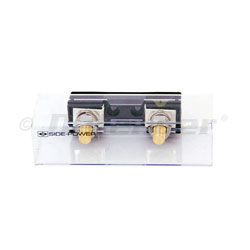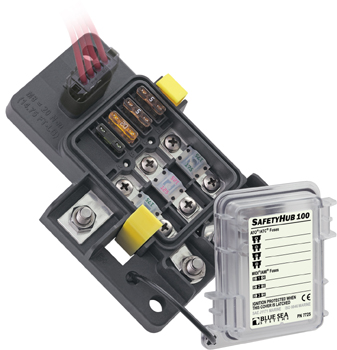Examine This Report on Blue Sea Fuse Block
Wiki Article
Blue Sea Fuse Block Can Be Fun For Everyone
Table of ContentsBlue Sea Fuse Block Fundamentals ExplainedGetting The Blue Sea Fuse Block To WorkBlue Sea Fuse Block Can Be Fun For EveryoneThe 6-Second Trick For Blue Sea Fuse BlockThe Facts About Blue Sea Fuse Block Uncovered
If the existing exceeds the AIC degree, the device may arc throughout or develop a few other conductive course, and also fail to do its work. The ABYC requires air conditioner and DC breaker to have a minimal AIC rating of 3,000 amps in many circumstances, and also 5,000 amps in some.These are used to determine the optimum circuit breaker or fuse ranking (you can always go lower)., for a provided conductor dimension (e.


Rumored Buzz on Blue Sea Fuse Block
g., 00, commonly composed as 2/0, or 000, created as 3/0, and so on). The European system just measures the size, or cross-sectional area, of the copper in a conductor and also utilizes that. Not only are united state wire sizes counterproductive, yet there are additionally two different conductor-sizing solutions utilizing the exact same numbering system.

To cope with this situation, the higher the number of conductors in a bundle, the extra the current-carrying ability (ampacity) of the individual conductors is de-rated. This is done by using a de-rating aspect. Up until just recently the ABYC applied this de-rating of packed conductors only to circuits lugging greater than 60V, which in functional boating applications suggests a/c circuits, yet the ABYC now likewise partly uses de-rating to DC circuits.
The Facts About Blue Sea Fuse Block Uncovered
You can find a PDF variation of these tables and a description on just how to use them here. A curled shore-power cord being in the sun is one instance not covered by bundling and also other rules for which a cable must still be derated due to heat. The combined results of the coiling (basically, a type of bundling) and also solar home heating can effectively derate a shore-power cord by as high as 50%.A conductor must be derated whenever there is any type of obstruction to dissipating the warmth generated within it. here Ultimately, note that many cabling used in U.S.-built boats has an insulation temperature level rating of 105C/221F, in contrast to the 90C/194F or even 60C/140F cabling located in many European-built boats. The insulation temperature ranking should be printed on the cord, and also if it is not, the wire does not comply with ABYC requirements.
As kept in mind above, in some scenarios a reduced conductor insulation rating may be chosen. If any type of component of the circuit being protected is inside an engineroom, the Inside Engine Spaces sub-column is utilized to figure great site out the optimum allowed OCP, however otherwise, the Outside Engine Spaces sub-column is relevant (blue sea fuse block). If the conductor remains in a package, apply the ideal de-rating variable based upon the number of conductors in that bundle.
10 Simple Techniques For Blue Sea Fuse Block
If there is no specific suit in between the resulting conductor ampacity as well as offered fuse or circuit breaker ratings, the ABYC standards permit the following highest possible ranked fuse or breaker to be utilized on all however main circulation panel integrates as well as breakers (these can not surpass 100% of the circuit rating), as long as the fuse or breaker's rating does not go beyond 150% of the ampacity of the conductor it is protecting.Circuit breakers require to match the ampacity of the wires they are shielding! Establish whether a fuse or a circuit breaker is extra ideal for the job. Figure out the ampacity of the smallest conductor to be shielded by the overcurrent device. Determine the maximum continual present that will move on the circuit.
Sometimes, specifically with bilge pumps, there is a long run of partially sized wiring to the electric motor (blue sea fuse block). If a locked-rotor condition establishes, the total resistance in the circuit might suffice to restrict the present circulation to a level that will not journey the breaker or blow the fuse however which however is high enough over time to begin a fire at the pump.
Blue Sea Fuse Block Fundamentals Explained
The conductor size need to be raised so that the voltage decline on the circuit is reduced to a degree at which sufficient present to trip the breaker or blow the fuse can stream. Anyway, the ABYC requires that all electric motors and electric motor circuits be created and also secured to make sure that they can endure a locked-rotor problem for 7 hours without developing a fire hazard.Fairly low-cost as well as small breakers ranked at approximately 150 amps are currently extensively available, together with go to my site inexpensive, small merges as much as 800 amps. There is just no reason for not safeguarding all high-current circuits, including cranking circuits. Common amperage scores for typical marine fuse types. Various other dimensions may be readily available but tough to locate.
The neatest way to handle them, and give the needed overcurrent security, is to run a single hefty conductor, generally 2/0 gauge (70mm), from the positive post on the residence batteries to a battery-isolation switch. This conductor needs to be appropriately fused as near the battery as possible. If the conductor is bolted (as opposed to secured) to the battery article, there are purpose-built fuses that can be included at the battery message itself (MRBF fuses).
Report this wiki page